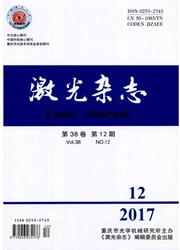

 中文摘要:
中文摘要:
全息曝光系统像差对光栅拼接精度及其远场衍射光斑能量分布有直接影响。根据全息曝光拼接方案提出了一种拼接光栅像差分析方法。模拟了全息曝光波面随机初级像差,利用500个曝光波面进行了光栅拼接统计,得到了米量级三拼光栅记录波像差和拼接精度,通过统计分析得到理想拼接情况下拼接引入的像差成份不到整体波面像差的10%。考虑到光栅衍射波像差包括记录像差和光栅基片面形,计算了不同拼接精度情况下一级衍射波面及远场衍射光强分布,对衍射波面PV值、远场光能量比和斯特列而比进行了统计分析,得到了拼接误差与衍射波面及远场光斑之间的关系。在拼缝误差为0.1λ以内时,远场光斑能量集中度和斯特列尔比的变化量可分别控制在5%以内。本文为米量级全息拼接光栅制造提供了理论支撑。
 英文摘要:
英文摘要:
The far-field diffraction intensity of mosaic grating is not only influenced by the grating's mosaic precision but also by the wave aberration of the holographic exposure system. A method based on holographic exposure is presented to analyze diffraction wave aberration of the mosaic grating. 500 wave surfaces with primary aberration have been simulated to make three sub - gratings on the one sttbstrate which is covered by photoresist. And we come to the conclusion that the error introduced by the perfect mosaic process is less than 10 percents of the total wave aberration. Considering with the grating' s diffraction aberration and the mosaic accuracy, PV value of the diffraction wave front, energy ratio and Strehl ratio of far field intensity are calculated for statistical analysis. And the relationship between mosaic error and the diffraction wave front and far field intensity distribution is obtained. The mosaic accuracy of 0.1 λ, means 5 % decrease of the Strehl ratio. This paper provides theoretical support for the fabrication of meter - sized grating by holographic exposure.
 同期刊论文项目
同期刊论文项目
 同项目期刊论文
同项目期刊论文
 期刊信息
期刊信息
